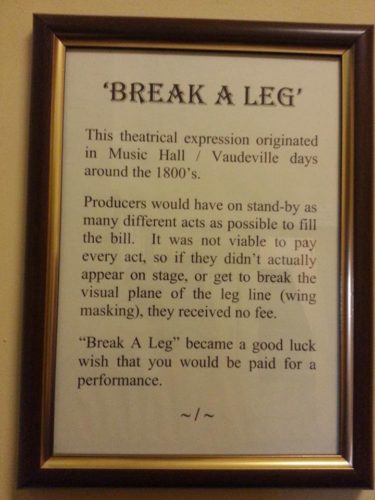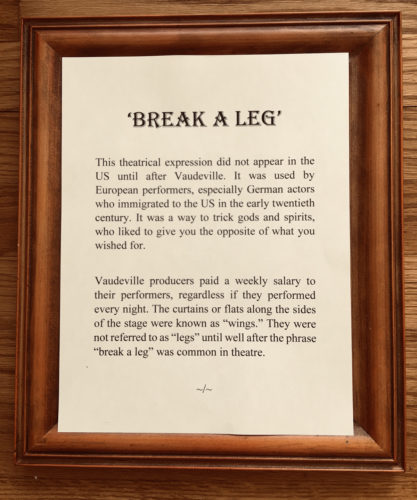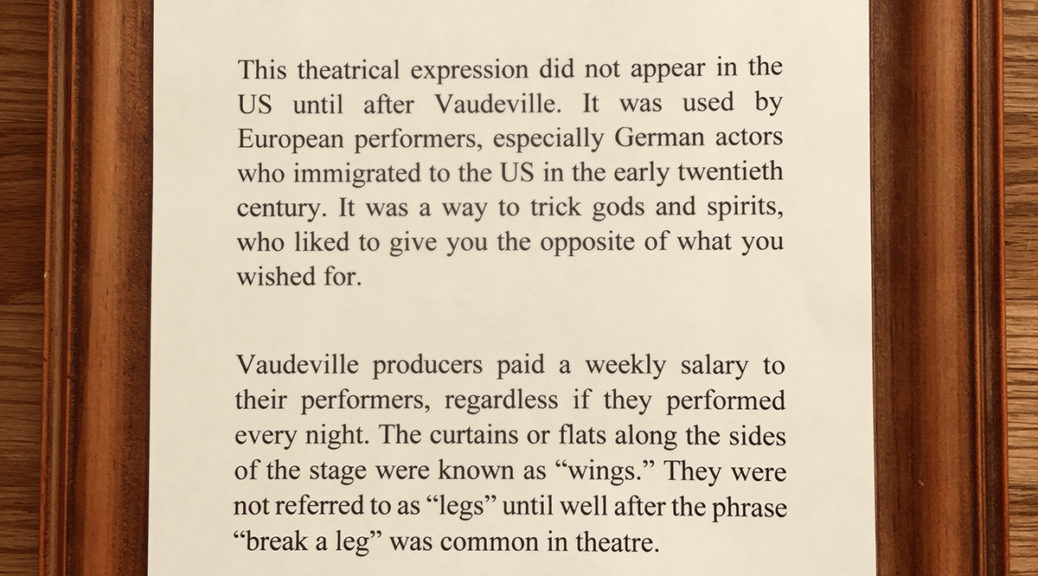Anyone who has spent any time in the theater has heard the phrase “Break a leg!” It is the traditional means of wishing good luck for a performer.
There is a certain image (as seen below) making the rounds again, which makes a bold claim about the origin of this phrase. The first time I saw it, I made a note to do some research; it makes a claim that I have not seen anywhere else. For a few days, I disappeared down a rabbit hole of theatrical superstitions and practices on Vaudeville, but I never posted it. Now that I have been seeing this image again, I realized I wanted to set the record straight.

The plaque reads:
Break a Leg. This theatrical expression originated in Music Hall/Vaudeville days around the 1800’s.
Producers would have on stand-by as many different acts as possible to fill the bill. It was not viable to pay every act, so if they didn’t actually appear on stage, or get to break the visual plane of the leg line (wing masking), they received no fee.
“Break A Leg” became a good luck wish that you would be paid for a performance.
I am not sure where this plaque is from. This image seems to have appeared on the internet around 2013. I have not seen this theory or text anywhere else except in reference to this image. Unfortunately, this theory has since appeared in other books and websites, but it all originates with this image. Internet images like this spread quickly.
As a props person, I do a lot of research. Images like this raise a few red flags. An unsourced and unverified claim does not become true simply because you print it out, put it in a frame, and take a photo of it.
First, let us look at some of the more commonly accepted theories to the origin of the phrase. Then we can look at why the particular details in this plaque do not add up.
Where does “Break a Leg” come from?
The most general theory of the phrase has to do with the idea of “opposite luck.” In the 1981 book “The Curse of Macbeth” by Richard Huggett, he explains that if you wish someone good luck, then you are drawing attention to their desperate need for fortune and tempting the Gods to bring hostile intervention. Also, giving another person good luck means you remove that luck from yourself. Therefore, you make a wish for something bad to happen, and the opposite will occur.
Huggett continues by writing, “In recent years a curious and rather repulsive tradition borrowed from the continent has grown up of offering gruesome first night wishes like ‘break a leg’ or ‘fall down backwards’ or ‘give them hell’ or ‘go and perform an impossible action’, or just a stream of good-natured obscenities.”
Two things are interesting here. First is that he says the tradition has only come about recently, and second that the tradition comes from the continent (more on that later).
When Does the Phrase First Appear?
The earliest example of the phrase “break a leg” comes from a 1921 article in The New Statesman titled “A Defence of Superstition.” In it, Robert Wilson Lynd writes:
The stage is, perhaps, the most superstitious institution in England, after the race course. The latter is so superstitious that to wish a man luck when on his way to a race-meeting is considered unlucky. Instead of saying ‘Good luck!’ you should say something insulting such as, ‘May you break your leg!’ We have known an Irish race-goer’s day to be clouded because someone wished him good fortune. Actors and actresses have not only all the ordinary superstitions, such as the picking up of pins, the dread of breaking looking-glasses, and the horror of certain numbers – they also have a number of professional superstitions.
What struck me is that Lynd is specifically talking about the superstitions of the theatre, but he attributes the phrase “break a leg” to gamblers at a race track. Again, it is clear that the phrase is used as a form of opposite luck; it has nothing to do with the specific terminology of theater (breaking the visual plane of the leg line).
One of the earliest published uses of the phrase as a theater superstition is found in Edna Ferber’s A Peculiar Treasure: An Autobiography, published in 1939. During the final dress rehearsal, she observes “all the understudies sitting in the back row politely wishing the various principals would break a leg.”
I also found an interesting anecdote from the 1985 biography of Helen Hayes, written by Kenneth Barrow. Hayes was of course the “First Lady of the American Theater,” and in the early 1930s, she began starring in Hollywood films.
Helen’s dressing room was immediately across the corridor from one of Paramount’s leading contract players, Marlene Dietrich. On her first day of shooting Miss Dietrich appeared in her doorway and said, “I hope you break your leg.” Helen was shocked beyond belief. She had heard of the bitchiness of Hollywood actresses but had never believed that a complete stranger could be so brutal and callous. Later someone told her that in Europe it was considered unlucky to wish someone luck in the theatre and that “Break a leg” was standard form and she realized her mistake.
Now, if the First Lady of American theater was unfamiliar with this theatrical superstition until the 1930s, surely it cannot have come from Vaudeville!
Hals- und Beinbruch
So far, we have good evidence that the phrase first came from the continent (ie Europe) and that it was unheard of in America until the 1920s or 30s. Marlene Dietrich was born in Germany and performed on stage and screen there until 1930, when she moved to Hollywood. The Germans have a phrase, “Hals- und Beinbruch,” which translates literally to “break your neck and leg,” but which is used to wish luck upon others. It has been attributed to hunters, to travelers, and evidence exists that German pilots in the First World War used it to give each other “opposite luck.”
Some etymologists believe the phrase originates from the Yiddish הצלחה ×ון ברכה, which means “success and blessing.” It is romanized as hatslokhe u brokhe, which sounds similar to the German Hals- und Beinbruch. And so, the theory goes, the Germans heard Yiddish speakers wish each other luck with the phrase, and started wishing themselves luck with a similar sounding phrase in their own language.
In any case, it seems likely the phrase came to America through German or Yiddish speakers, possibly from Marlene Dietrich herself, and remained in use by theater people to the current day.
Other Theatrical Superstitions
Many writers agree that theater folk are among the most superstitious of any group. I have found a long history of authors attempting to document their many beliefs. Out of curiosity, I looked to see if “breaking a leg” was ever recorded as one of those superstitions. Out of 28 magazine and newspaper articles which discuss theatrical superstitions published between 1885 and 1940, not a single one mentions the use of “breaking a leg.”
Many of our contemporary superstitions are mentioned: never utter the last line of a play during rehearsal, peacock feathers on stage are unlucky, and avoid saying the Witch’s spell from Macbeth. Other superstitions have long been forgotten, such as having bad luck if a cross-eyed patron is in the audience, or bringing good luck by rubbing a baby against the scenery before the show opens.
Vaudeville in the 1800s
So besides looking at the actual documented origin of the phrase “break a leg!”, I also wanted to point out why the proposed origin in this plaque rings false. This type of writing (which always seems to go viral) uses vague words and phrases (like “back then” or “in the old days”). It feels true with a quick glance but falls apart when you dig deeper.
In the US, “Vaudeville” began to appear around the 1860s, spiked in popularity around the 1890s, and began dying off in the 1930s. Earlier types of variety shows, such as burlesque, circuses, and minstrel shows existed in much smaller forms in the early 1800s.
“Music Hall”, on the other hand, was more of an English art form which began around the 1850s and lasted until the First World War.
Both Vaudeville and Music Hall were quite distinct from each other, and each one evolved and changed greatly over the decades, so to lump them both together as some homogenous “thing” is sloppy at best. You cannot declare what “producers” did without being much more specific about the year and place you are discussing.
I will admit I am not an expert on either Vaudeville or Music Hall, but everything I’ve read about professional Vaudeville producers indicates they hired performers on a weekly salary. I found nothing about booking extra acts and only paying them if they actually performed that night. Again, the history of both these art forms evolved quite a bit, so it is possible that this was true in some early form of variety show in some location, but as far as common professional practices during Vaudeville’s heyday, this did not happen.
In the Wings
As a final nail in the coffin, I don’t think Vaudeville theaters even had legs. Certainly the Music Halls of England didn’t; they typically contained a raised platform inside of a bar or dining room, and did not have a proscenium with wings.
In most books about the Vaudeville theatre written at the time, they describe the stage as being framed by a proscenium, with the side drapes just upstage of the proscenium called “tormentors.” The side curtains behind the tormentors are referred to as “wings.” In many cases, they are not drapes, but hard-framed pieces of canvas. I did not find any contemporaneous books which referred to them as “legs.”
The use of the word “leg” at the time is best defined in this 1909 magazine article called “The Scenic Artist at Work,” by Shirley Burns.
Each piece has a technical name. The canvas that forms the background is called the “back drop.” The isolated partitions that are set one back of the other at the side of the stage are the “wings.” Then there are the “single-leg” and the “double-leg” drops. That is, if you see a tree trunk at one side of the stage, with its branches spreading across the stage, it is known as a “single-leg” drop. But if the canvas reaches not only across the stage, but spreads to the floor on both sides, it is known as a “double-leg drop.” The sky, ceiling, and overhanging foliage are called the “borders.”
To sum up, theaters in the time of Vaudeville were outfitted with borders and wings. Only cut painted drops would have legs, and those would be attached to the portion which also hung above the stage. It is not until books from the 1950s where I have started finding the word “leg” being used as a synonym of “wing” to refer to the generic theatrical drapes.
Conclusion
The most likely use of the phrase “break a leg” is that you avoid bad luck by wishing for something bad to happen. This kind of folksy superstition has a long tradition throughout Europe, with a very similar phrase appearing in Germany. German performers immigrated to the American stage in the early twentieth century, and we see the phrase appear around the 1920s and 1930s. It was basically non-existent before then.
The phrase did not appear in America when Vaudeville was popular. Vaudeville producers did not book more acts than they needed, and performers were paid weekly, whether or not they appeared on stage every night. The curtains along the side of the stage were commonly referred to as “wings”, and were not called “legs” until after the phrase “break a leg” was in popular use.

Why do memes like this plaque become so popular on the internet even though they are clearly wrong? We all like to think there is some secret knowledge that sets us apart from everyone else. When something is common knowledge, it can make us feel good when we discover that it is actually wrong, and that everyone else is mistaken. So when an image like this comes along, it gives us a rush that we have uncovered this forgotten information. But this should always be a red flag in our research. We should not ignore the overwhelming facts and consensus of experts in favor of a single baseless claim.






that was a fascinating story! Thanks for sharing it!